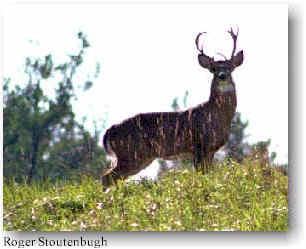Deer

White-tailed deer are commonly observed on roadsides, crossing the firebreaks, and feeding on lawns and recreation fields. Due to the relatively poor browse, the average body size of the deer in central Long Island is generally smaller than that in other portions of New York. In general most does have twins, but it is not uncommon for a doe to have triplets. The diversity in habitat (lawns, mowed roadsides, open fields) as well as the current protection from hunting has probably resulted in a greater density of deer on the BNL site than would be expected in an unaltered Pine Barrens habitat. Due to the large population density of deer onsite, the Laboratory is considering alternatives for deer management.
White-tailed Deer (Odocoileus virginianus)
White-tailed deer typically have a home range of 2-3 square miles, depending on the quality of the habitat (DeGraaf & Rudis, 1983). On Long Island, deer general travel less than a mile within their home range. Greater travel distances, up to 10 miles, are seen in dispersing males. Preferred habitat consists of forest edges, swamp borders, and areas interspersed with fields and woodland openings. Young (one to two fawns) are typically produced in May and June. Deer are adaptable in their food habits, feeding on grasses, herbs, and aquatic plants in summer and buds, twigs, and some conifers in winter. Deer have heavily browsed yew bushes, particularly those in the tree plantations.
Causes of mortality for white-tailed deer on the site include roadkill, domestic dogs, illegal hunting, and starvation. In the past deer with healed, but previously broken, legs have been observed. BNL employees have related that domestic dogs from nearby developments often pursue and kill deer on site. One deer skeleton with a broadhead (arrow point) embedded in the shoulder blade was found in 1993 (several tree stands [hunting platforms] were observed along the east property line and near Half Moon Pond). Deer are periodically harvested by BNL as part of ongoing environmental monitoring.
Concentration of Cesium-137 (Cs-137) in Deer Meat are monitored
Based on data collected since 1992, analysis of meat from white-tailed deer (Odocoileus virginianus)
- Samples collected onsite have shown concentrations of Cs-137 that are above background (1992-1997 Annual Site Environmental Reports). An evaluation by NYSDEC Wildlife Branch and the NYS Department of Health (NYSDOH) in 1999 concluded that the level of Cs-137 in meat does not pose a risk to human health when such meat is consumed (Bureau of Environmental Radiation Protection, NYSDOH March 1999). (Note: Hunting has not been allowed at the BNL site since the mid-1980s, for security reasons. Although deer have a limited range--approximately one mile, according to the NYSDEC—some do move off-site).
- The NYSDOH study also concluded that the elevated levels should not impact deer health.
- Monitoring of soil, vegetation, and deer meat from onsite locations over the past several years indicates that the Cs-137 concentration levels have been decreasing. This decrease is expected to continue with time due to natural radioactive decay, as no new Cs-137 is being added to the environment from BNL operations.
- Contaminated areas have been addressed, soil removed and disposed of, under the Environmental Restoration Program.
References:
- December 1994; Sitewide Biological Inventory, Phase II.
- December 2003; Natural Resource Management Plan for Brookhaven National Laboratory, BNL-71870-2003
Note: Text citation may be found in the above reference documents.


